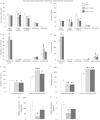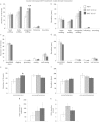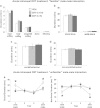Chronic and acute intranasal oxytocin produce divergent social effects in mice
- PMID: 24190025
- PMCID: PMC3957104
- DOI: 10.1038/npp.2013.310
Chronic and acute intranasal oxytocin produce divergent social effects in mice
Abstract
Intranasal administration of oxytocin (OXT) might be a promising new adjunctive therapy for mental disorders characterized by social behavioral alterations such as autism and schizophrenia. Despite promising initial studies in humans, it is not yet clear the specificity of the behavioral effects induced by chronic intranasal OXT and if chronic intranasal OXT could have different effects compared with single administration. This is critical for the aforementioned chronic mental disorders that might potentially involve life-long treatments. As a first step to address these issues, here we report that chronic intranasal OXT treatment in wild-type C57BL/6J adult mice produced a selective reduction of social behaviors concomitant to a reduction of the OXT receptors throughout the brain. Conversely, acute intranasal OXT treatment produced partial increases in social behaviors towards opposite-sex novel-stimulus female mice, while on the other hand, it decreased social exploration of same-sex novel stimulus male mice, without affecting social behavior towards familiar stimulus male mice. Finally, prolonged exposure to intranasal OXT treatments did not alter, in wild-type animals, parameters of general health such as body weight, locomotor activity, olfactory and auditory functions, nor parameters of memory and sensorimotor gating abilities. These results indicate that a prolonged over-stimulation of a 'healthy' oxytocinergic brain system, with no inherent deficits in social interaction and normal endogenous levels of OXT, results in specific detrimental effects in social behaviors.
Figures





Similar articles
-
Intranasal Oxytocin and Vasopressin Modulate Divergent Brainwide Functional Substrates.Neuropsychopharmacology. 2017 Jun;42(7):1420-1434. doi: 10.1038/npp.2016.283. Epub 2016 Dec 20. Neuropsychopharmacology. 2017. PMID: 27995932 Free PMC article.
-
Chronic intranasal oxytocin reverses stress-induced social avoidance in female prairie voles.Neuropharmacology. 2021 Oct 15;198:108770. doi: 10.1016/j.neuropharm.2021.108770. Epub 2021 Aug 28. Neuropharmacology. 2021. PMID: 34461067
-
Effects of oxytocin on prosocial behavior and the associated profiles of oxytocinergic and corticotropin-releasing hormone receptors in a rodent model of posttraumatic stress disorder.J Biomed Sci. 2019 Mar 21;26(1):26. doi: 10.1186/s12929-019-0514-0. J Biomed Sci. 2019. PMID: 30898126 Free PMC article.
-
Role of oxytocin in the neuroadaptation to drugs of abuse.Psychoneuroendocrinology. 1994;19(1):85-117. doi: 10.1016/0306-4530(94)90062-0. Psychoneuroendocrinology. 1994. PMID: 9210215 Review.
-
The use of intranasal oxytocin in the treatment of eating disorders.Neuropeptides. 2023 Dec;102:102387. doi: 10.1016/j.npep.2023.102387. Epub 2023 Oct 12. Neuropeptides. 2023. PMID: 37837804 Review.
Cited by
-
From Parental Behavior to Sexual Function: Recent Advances in Oxytocin Research.Curr Sex Health Rep. 2024;16(3):119-130. doi: 10.1007/s11930-024-00386-1. Epub 2024 May 11. Curr Sex Health Rep. 2024. PMID: 39224135 Free PMC article. Review.
-
A 12-week randomized controlled trial of twice-daily intranasal oxytocin for social cognitive deficits in people with schizophrenia.Schizophr Res. 2017 Jul;185:88-95. doi: 10.1016/j.schres.2017.01.008. Epub 2017 Jan 13. Schizophr Res. 2017. PMID: 28094169 Free PMC article. Clinical Trial.
-
Oxytocin enhances observational fear in mice.Nat Commun. 2017 Dec 13;8(1):2102. doi: 10.1038/s41467-017-02279-5. Nat Commun. 2017. PMID: 29235461 Free PMC article.
-
Targeting the hypothalamus for modeling age-related DNA methylation and developing OXT-GnRH combinational therapy against Alzheimer's disease-like pathologies in male mouse model.Nat Commun. 2024 Oct 31;15(1):9419. doi: 10.1038/s41467-024-53507-8. Nat Commun. 2024. PMID: 39482312 Free PMC article.
-
Adaptive crossover designs for assessment of symptomatic treatments targeting behaviour in neurodegenerative disease: a phase 2 clinical trial of intranasal oxytocin for frontotemporal dementia (FOXY).Alzheimers Res Ther. 2018 Sep 27;10(1):102. doi: 10.1186/s13195-018-0427-2. Alzheimers Res Ther. 2018. PMID: 30261917 Free PMC article. Clinical Trial.
References
-
- Arletti R, Bazzani C, Castelli M, Bertolini A. Oxytocin improves male copulatory performance in rats. Horm Behav. 1985;19:14–20. - PubMed
Publication types
MeSH terms
Substances
Grants and funding
LinkOut - more resources
Full Text Sources
Other Literature Sources
Research Materials

